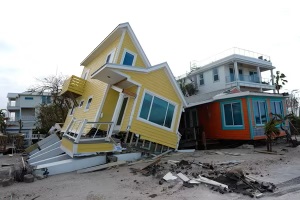Hurricanes Helene and Milton come calling

By RICHARD WESLEY
On Thursday, Sept. 26, Hurricane Helene slammed into Florida’s panhandle out of the Gulf of Mexico, causing massive devastation with a powerful storm surge. But Helene’s path of wreckage had only just begun, as it tore through the southern Appalachian Mountains of Georgia, South and North Carolina, and Virginia. The storm dumped record rainfall, and catastrophic flooding wiped out homes and entire communities. Communication systems were disrupted, power was lost, and roadways were washed out, making contact and access next to impossible for some. To date over 250 bodies have been recovered, with many more missing, making this one of the deadliest hurricanes on record.
In the immediate aftermath, there was an outpouring of care and concern, with neighbors overcoming all that separated them, pulling together to provide water, food, and shelter. Volunteers from near and far donated recovery services and money to help the victims. FEMA and the National Guard were mobilized to provide aid and assistance. Politicians, predictably, tried to score points by alternating compassion and blame, setting up photo ops to validate their concern.
Two weeks later, the potentially even more destructive category 5 Hurricane Milton bore down on Florida’s west coast, ripping through Tampa and Orlando before heading out to the Atlantic. While there was considerably less loss of life, the damage was extensive—flooding communities, smashing residential neighborhoods, and even tearing off the roof of Tropicana Field, home of the Tampa Bay Rays baseball team.
There are serious questions that are seldom asked in the wake of such terrible tragedies. Chief among them is: “How could this happen, and what can be done to prevent it happening again, and again, and again?”
The science is very clear. The growing intensity of hurricanes is the outcome of global climate change. As the atmosphere warms, primarily due to fossil fuel emissions, the oceans absorb the heat. NASA data since 1955 shows that 90% of global warming occurs in the oceans. This also contributes to sea-level rise as warmer water expands. When a tropical depression forms over warm water, clouds absorb the warm water in increasing volume. Citing data from the recent Fifth National Climate Assessment, completed last year, researchers found that the amount of precipitation in the most intense rainstorms has increased by 37% in the southeast since 1958 (see Lucy Dean Stockton and Freddy Brewster in The Lever, Oct. 2, 2024).
In the United States, we have one major political party that is led by a coterie of climate deniers, whose leader proclaims the answer to economic woes as “Drill, baby, drill!” Remarkably, the Republican governor of Florida, Ron DeSantis, signed a bill in May banning the use of the term “climate change” in official documents. He also banned wind turbines offshore and expanded the provisions for natural gas. While surveying the damage from Milton on Oct. 10, DeSantis declared to the media that such hurricanes are “kind of normal” and “to be expected” in Florida, and that climate change had nothing to do with it. This was after a summer in which Florida endured record levels of heat. In fact, the Coral Restoration Foundation recorded in July that coral at Sombrero Reef, off the coast of the Florida Keys, had suffered 100% mortality due to the extreme warmth of the ocean water.
The other major party touts a transition to alternative energy techniques (wind, solar, lithium battery vehicles), while still subsidizing fossil-fuel industries and cutting compromises with their defenders. The topic of climate mitigation has rarely come up in the 2024 campaign by Democrats. That may be because the Biden administration has handed out 1450 new oil and gas licenses, accounting for half the global number, and 20% more licenses than those issued by Donald Trump. Not under consideration is the demand for the payment of reparations for the damages wrought by extractive industries.
Of course, climate mitigation is an extremely complex global problem. The atmosphere and the oceans are no respecter of political boundaries, economic systems, or ideologies. However, the role that profit-driven capitalism has played as the engine of climate change cannot be denied. A week ago, Britain celebrated the closure of its last coal-fueled electrical plant. While this was a welcomed event, the fact remains that the emissions of carbon from the past two centuries of coal-fired energy are still in our atmosphere, and will not be erased for decades to come. The same can be said for all the oil, gas, and methane emissions of the industrial nations for previous centuries.
On the face of it, the biennial COP (Conference of Parties) gatherings might portend the sort of international cooperation that would address these issues. However, they have been over-represented by the fossil-fuel-export nations and their minions, seeking to protect their profits. The next COP is coming up this November in Baku, Azerbaijan—a major exporter of oil and natural gas. It would be a mistake to count on any major climate policy initiatives emerging from Baku. Previous COP events, including the Paris COP 21, have been a venue for promises never kept.
What is needed is less leadership “from above,” and more mass demand “from below.” Without a reversal of the current dynamic of inaction, we can expect a future of more devastation from wildfires, drought, and monster storms.
This struggle will not be easy. Already, the fossil-fuel capitalists and their legislative lackeys are passing and initiating measures to criminalize peaceful protests by climate activists. These laws are frequently written by lobbyists and call for fines—and even imprisonment—for terms up to 10 years. The resolve of the resistance must be strong. Socialists are committed to this struggle and to bringing revolutionary change.




